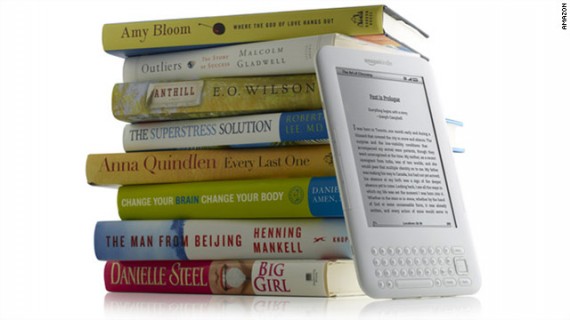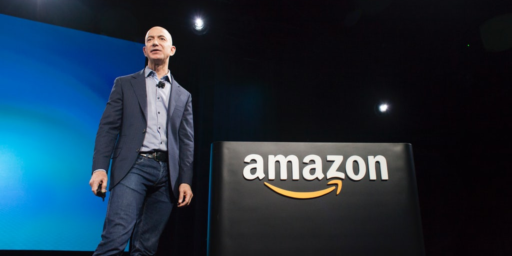Amazon Now Sells More E-Books Than Print Books
The death of the print book continues apace:
As further proof of how digital media dominate today’s entertainment, Amazon announced Thursday that its customers now buy more e-books for its Kindle device than all print books — hardcover and paperback — combined.
Given that people seem to spend more and more of their time peering at glowing electronic screens, this was probably bound to happen.
Still, the swiftness of this sea change — three-and-a-half years after the Kindle hit the market — appeared to catch even Amazon by surprise.
“Customers are now choosing Kindle books more often than print books. We had high hopes that this would happen eventually, but we never imagined it would happen this quickly — we’ve been selling print books for 15 years and Kindle books for less than four years,” said Jeff Bezos, Amazon’s CEO, in a statement.
Amazon introduced the Kindle e-reader in November 2007. By July 2010, Kindle book sales had surpassed hardcover book sales, and six months later, Kindle books overtook paperback books to become the most popular format on Amazon.com, the online retailer said.
Outside Amazon, it’s a slightly different story but electronic books remain a bright spot in an otherwise gloomy market:
Of course, these stats only represent sales of books on Amazon.com, the only place consumers can buy e-books for the Kindle. When sales of books from other websites and brick-and-mortar stores are factored in, e-books still represent a small minority of all titles purchased, although some analysts predict they could reach 20% within a year or two.
The growth of electronic books has been a bright spot in an otherwise struggling publishing industry. Sales revenue from e-books were up 145.7% in March of this year compared with March 2010, according to the Association of American Publishers. At the same time, adult hardcover sales increased 6%, while mass market books — less-expensive paperbacks — grew by 1.2%.
Personally, I wasn’t sure how eager people would be to read books off a screen rather than holding them in their hand. The key seems to be that Amazon created a device that is both easy to use and easy to transport, and now it seems that Kindles are as ubiquitous at my local Starbucks or Panera as laptops and smartphones are. At this point, I can only assume that the format will continue to grow.
Photo via CNN







I know that I’ve actually found myself reading more books since I bought my Kindle last year.
It’s a shame that Mr Griggs has apparently never seen a Kindle, despite the fact that he was assigned to write this article.
Note to Mr. Accredited Journalist: The Kindle’s screen does not glow in any way. It’s kinda what makes a Kindle, well…a Kindle.
The story is much bigger than the electronic versus print book issue. Amazon is allowing writers to publish their own works on Kindle without going through the ancient gatekeepers of New York publishing houses and their editors.
This is changing everything in the writing world. Right now published authors like myself are looking at the payoff of selling a $3.99 book on Kindle and getting 75% of a profit, or selling a $24.95 hardcover through an agent and a publishing house and getting about 8% of the profit. I can now double my profit and reach a larger audience. In the past, “self-publishing” was a dead end because you couldn’t get distribution. Amazon is taking care of that. You can reach an audience world-wide now.
It’s more than big. It’s a tsunami.
I’ve just published book 4 of a 6 book series. The 4th book outperformed the 3rd book but 100% of the growth was in e-book.
On Bonnie’s point above, I warned my publisher more than 3 years ago that Amazon would be making a major move into publishing, and predicted they would very quickly become the largest publisher in the world.
Barnes and Noble now stands alone as the counterpoint to Amazon. Don’t count them out, but they need to radically change their store concept. The great weakness of e-books is the online stores — Amazon, BN, Apple. None of them offer you a great browsing experience. If you know precisely what you’re looking for, fine, otherwise they’re a mess.
What BN should do is stock more titles with fewer volumes of each, and maximize the store for browsing and electronic purchases. You could browse the shelves, spot something you like and right there on the spot download or order or buy. You keep the browsing experience, the coffee shop, etc… but with fast free WiFi and scannable QR codes so that a purchase is absolutely effortless.
I haven’t made the move to e-books as yet but comparing the bricks and mortar of BN to Amazon by recent experience, BN is DIW. Deciding I wanted a recently published book, I decided to give the local merchant a bit of business instead of ordering online. All I can say, is BN needs to find a book on merchandizing and soon. First, it was not easy to find the section needed, then the history books are by random period that my book didn’t fit in nicely. The help staff were always busy or missing. I wanted to ask as long ago a friend started working at one of the major bookstores and found Zen and the Art of Motorcycle Maintenance in the automotive section so miss shelving is always a possibility when titles are made for simple minds. I tried their terminal to search. My god, it was slow and right in the main aisle where passersby bumped you. I gave up, ordered the book and several more that would never have been in the physical store from Amazon in a nice peaceful experience.
The publishing industry seem to be clueless when it comes to modern ways to sell books. Instead they’ve made the browsing experience unpleasant to drive customers from their stores and drive them to Amazon.
I can sit in the same chair my grandfather set in and read the same books he read. My grandchildren will sit in that chair someday, but I doubt they will be able to read using my Nook. We can read clay tables from around 2000 B.C. long after the civilization has fallen into ruins. I wonder if our electronic texts and other information will be available to future civilizations.